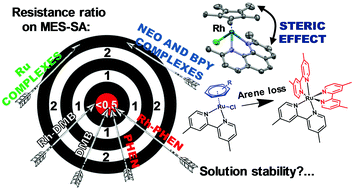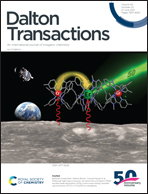Half-sandwich organometallic Ru and Rh complexes of (N,N) donor compounds: effect of ligand methylation on solution speciation and anticancer activity†
Abstract
A series of half-sandwich polypyridyl complexes was synthesized and compared focusing on structural, cytotoxic and aqueous solution behaviour. The formula of the synthesized complexes is [M(arene)(N,N)Cl]Cl, where M: Ru or Rh, arene: p-cymene, toluene or C5Me5−, (N,N): 2,2′-bipyridine (bpy), 4,4′-dimethyl-2,2′-bipyridine (dmb), 1,10-phenanthroline (phen) or 2,9-dimethyl-1,10-phenanthroline (neo). The structures of five half-sandwich complexes were determined by X-ray crystallography. It was found that introducing methyl groups next to the coordinating nitrogen atoms of the bidentate ligand causes steric congestion around the metal centre which changes the angle between ligand planes. The ligands and the Rh complexes showed significant cytotoxicity in A2780 and MES-SA cancer cell lines (IC50 = 0.1–56 μM) and in the cisplatin-resistant A2780cis cells. Paradoxically, phen and dmb as well as their half-sandwich Rh complexes showed increased toxicity against multidrug resistant MES-SA/Dx5 cells. In contrast, coordination to Ru caused loss of toxicity. Solution equilibrium constants showed that the studied metal complexes have high stability, and no dissociation was found for Ru and Rh complexes even at micromolar concentrations in a wide pH range. However, in the case of Ru complexes a slow and irreversible decomposition, namely arene loss, was also observed, which was more pronounced in light exposure in aqueous solution. In the case of neo, the methyl groups next to the nitrogen atoms significantly decrease the stability of complexes. For Rh complexes, the order of the stability constants corrected with ligand basicity (log K*): 9.78 (phen) > 9.01 (dmb) > 8.89 (bpy) > 3.93 (neo). The coordinated neo resulted in an enormous decrease in the chloride ion affinity of Ru compounds. Based on the results, a universal model was introduced for the prediction of chloride ion capability of half-sandwich Rh and Ru complexes. It combines the effects of the bidentate ligand and the M(arene) part using only two terms, performing multilinear regression procedure.



 Please wait while we load your content...
Please wait while we load your content...